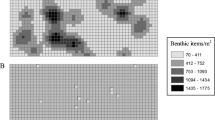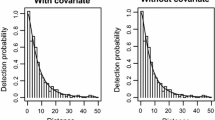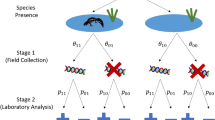Abstract
Adaptive sampling designs are recommended where, as is typical with freshwater mussels, the outcome of interest is rare and clustered. However, the performance of adaptive designs has not been investigated when outcomes are not only rare and clustered but also imperfectly detected. We address this combination of challenges using data simulated to mimic properties of freshwater mussels from a reach of the upper Mississippi River. Simulations were conducted under a range of sample sizes and detection probabilities. Under perfect detection, efficiency of the adaptive sampling design increased relative to the conventional design as sample size increased and as density decreased. Also, the probability of sampling occupied habitat was four times higher for adaptive than conventional sampling of the lowest density population examined. However, imperfect detection resulted in substantial biases in sample means and variances under both adaptive sampling and conventional designs. The efficiency of adaptive sampling declined with decreasing detectability. Also, the probability of encountering an occupied unit during adaptive sampling, relative to conventional sampling declined with decreasing detectability. Thus, the potential gains in the application of adaptive sampling to rare and clustered populations relative to conventional sampling are reduced when detection is imperfect. The results highlight the need to increase or estimate detection to improve performance of conventional and adaptive sampling designs.
Similar content being viewed by others
References
Amyot, J.-P., & Downing, J. A. (1991). Endo- and epibenthic distribution of the unionid mollusk Elliptio complanata. Journal of the North American Benthological Society, 10, 280–285.
Brown, J. A. (2003). Designing an efficient adaptive cluster sample. Environmental and Ecological Statistics, 10, 43–60.
Christman, M. C. (2000). A review of quadrat-based sampling or rare, geographically clustered populations. Journal of Agricultural, Biological, and Environmental Statistics, 5, 168–201.
Diggle, P. J. (1983). Statistical analysis of spatial point patterns. New York: Academic.
Downing, J. A., & Downing, W. L. (1992). Spatial aggregation, precision, and power in surveys of freshwater mussel populations. Canadian Journal of Fisheries and Aquatic Sciences, 49, 985–991.
Elliott, J. M. (1977). Some methods for the statistical analysis of samples of benthic invertebrates. Freshwater Biological Association Scientific Publication No. 25. Cumbria: Freshwater Biological Association.
Green, R. H., & Young, R. C. (1993). Sampling to detect rare species. Ecological Applications, 3, 351–356.
Holland-Bartels, L. E. (1990). Physical factors and their influence on the mussel fauna of a main channel border habitat of the upper Mississippi River. Journal of the North American Benthological Society, 9, 327–335.
Hornbach, D. J., & Deneka, T. (1996). A comparison of a qualitative and a quantitative collection method for examining freshwater mussel assemblages. Journal of the North American Benthological Society, 15, 587–596.
MacKenzie, D. I., Nichols, J. D., Lachman, G. B., Droege, S., Royle, J. A., & Langtimm, C. A. (2002). Estimating site occupancy rates when detection probabilities are less than one. Ecology, 83, 2248–2255.
MacKenzie, D. I., Nichols, J. D., Royle, J. A., Pollock, K. H., Bailey, L. L., & Hines, J. E. (2006). Occupancy estimation and modeling: Inferring patterns and dynamics of species occurrence. San Diego: Academic.
Morrison, L. W., Smith, D. R., Nichols, D., & Young, C. C. (2008). Using computer simulations to evaluate sample design: An example with the Missouri bladderpod. Population Ecology, 50, 417–425.
Perles, S. J., Christian, A. D., & Berg, D. J. (2003). Vertical migration, orientation, aggregation, and fecundity of the freshwater mussel Lampsilis siliquoidia. Ohio Journal of Science, 103, 73–78.
Pooler, P. S. & Smith, D. R. (2005). Optimal sampling design for estimating spatial distribution and abundance of a freshwater mussel population. Journal of North American Benthological Society, 24(3), 525-537.
Richardson, T. D., & Yokley, P. (1996). A note on sampling technique and evidence of recruitment in freshwater mussels (Unionidae). Archiv für Hydrobiologie, 137, 135–140.
Royle, J. A. (2006). Site occupancy models with heterogeneous detection probabilities. Biometrics, 62, 97–102.
Royle, J. A., & Nichols, J. D. (2003). Estimating abundance from repeated presence-absence data or point counts. Ecology, 84, 777–790.
Samuel, M. D., Garton, E. O., Schlegel, M. W., & Carson, R. G. (1987). Visibility bias during aerial surveys of elk in northcentral Idaho. Journal of Wildlife Management, 51, 622–630.
Smith, D. R. (2006). Survey design for detecting rare freshwater mussels. Journal of North American Benthological Society, 25, 701–711.
Smith, D. R., Brown, J. A., & Lo, N. C. H. (2004). Application of adaptive cluster sampling to biological populations. In W. L. Thompson (Ed.), Sampling rare or elusive species: Concepts, designs, and techniques for estimating population parameters (pp. 77–122). Covelo: Island.
Smith, D. R., Conroy, M. J., & Brakhage, D. H. (1995). Efficiency of adaptive cluster sampling for estimating density of wintering waterfowl. Biometrics, 51, 777–788.
Smith, D. R., Rogala, J. T., Gray, B. R., Zigler, S. J., & Newton, T. J. (in press) Evaluation of single and two-stage adaptive sampling designs for estimation of density and abundance of freshwater mussels in a large river. Rivers Research and Applications.
Smith, D. R., Villella, R. F., & Lemarie, D. P. (2001a). Survey protocol for assessment of endangered freshwater mussels in the Allegheny River. Journal of the North American Benthological Society, 20, 118–132.
Smith, D. R., Villella, R. F., & Lemari, D. P. (2003). Application of adaptive cluster sampling to low-density populations of freshwater mussels. Environmental and Ecological Statistics, 10, 7–15.
Smith, D. R., Villella, R. F., Lemarié, D. P., & von Oettingen, S. (2001b). How much excavation is needed to monitor freshwater mussels? In R. A. Tankersley, D. I. Warmolts, G. T. Watters, B. J. Armitage, P. D. Johnson, & R. S. Butler (Eds.), Freshwater mollusk symposium proceedings (pp. 203–218). Columbus: Ohio Biological Survey.
Steinhorst, R. K., & Samuel, M. D. (1989). Sightability adjustment methods for aerial surveys of wildlife populations. Biometrics, 45, 415–425.
Strayer, D. L., Claypool, S., & Sprague, S. (1997). Assessing unionid populations with quadrats and timed searches. In K. S. Cummings, A. C. Buchanan, C. A. Mayer, & T. J. Naimo (Eds.), Conservation and management of freshwater mussels II. initiatives for the future (pp. 163–169). Rock Island, Illinois: Upper Mississippi River Conservation Committee.
Strayer, D. L., Downing, J. A., Haag, W. R., King, T. L., Layzer, J. B., Newton, T. J., et al. (2004). Changing perspectives on pearly mussels, North America’s most imperiled animals. BioScience, 54, 429–439.
Strayer, D. L., & Smith, D. R. (2003). A guide to sampling freshwater mussel populations. American Fisheries Society Monograph No. 8.
Thompson, S. K. (1991). Adaptive cluster sampling: Designs with primary and secondary units. Biometrics, 47(3), 1103–1115.
Thompson, S. K. (2002). Sampling, 2nd Edn. New York: Wiley.
Thompson, S. K., & Seber, G. A. F. (1994). Detectability in conventional and adaptive sampling. Biometrics, 50, 712–724.
Watters, G. T., O’Dee, S. H., & Chordas, S. (2001). Patterns of vertical migration in freshwater mussels (Bivalvia: Unionida). Journal of Freshwater Ecology, 16, 541–550.
Author information
Authors and Affiliations
Corresponding author
Rights and permissions
About this article
Cite this article
Smith, D.R., Gray, B.R., Newton, T.J. et al. Effect of imperfect detectability on adaptive and conventional sampling: simulated sampling of freshwater mussels in the upper Mississippi River. Environ Monit Assess 170, 499–507 (2010). https://doi.org/10.1007/s10661-009-1251-8
Received:
Accepted:
Published:
Issue Date:
DOI: https://doi.org/10.1007/s10661-009-1251-8




